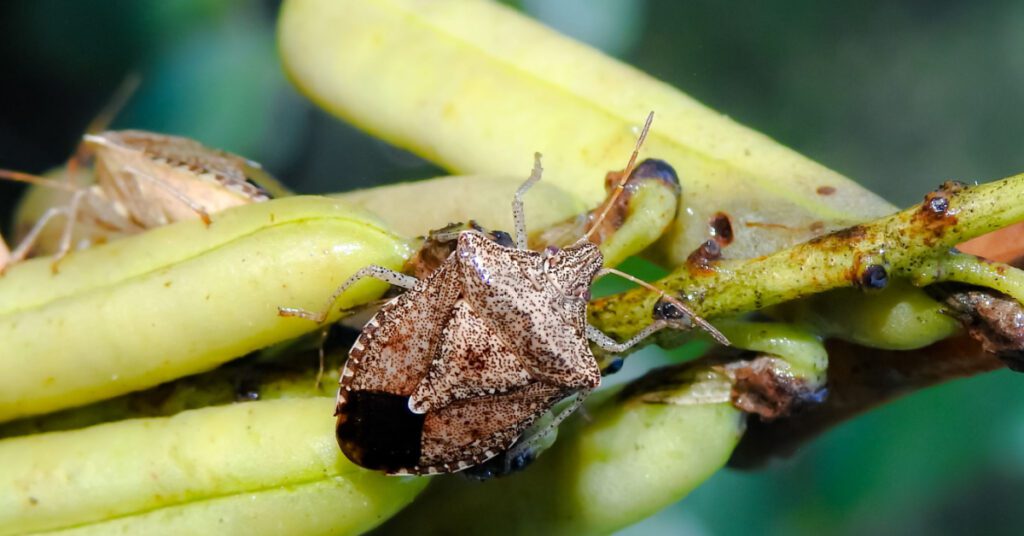Stink Bugs Identification, Control and Prevention
Stink bugs, scientifically known as Pentatomidae, have gained attention for their distinct odor and ability to become nuisance pests. With their shield-shaped bodies and varied colors, these insects have a unique appearance that sets them apart from other pests. This “Stink Bugs: Guide to Identification and Control” aims to help you identify stink bugs accurately and provide effective control strategies to manage infestations.
Identification of Stink Bugs
Stink bugs exhibit a wide range of appearances but share common characteristics that make their identification possible.
Physical Features
Stink bugs are often recognized by their characteristic shield-shaped bodies. They have six legs and a pair of antennae. The coloration varies, ranging among the many species from brown to green, red, light grey, copper or black, as some species might display vivid markings.
Distinct Patterns
There are many species of stink bugs, each with its own identifying characteristics with distinct patterns on their bodies, such as mottled or striped designs.
Brown Marmorated Stink Bug (Halyomorpha haly

In New Jersey, the stink bug with the most widespread presence is the Brown Marmorated Stink Bug (Halyomorpha halys), native to East Asia.
This invasive insect possesses a shield-shaped body that typically ranges from 12 to 17 millimeters. Its coloration, varying shades of brown, features lighter bands on the antennae and alternating dark and light patterns along the edges of its abdomen.
In New Jersey’s diverse landscape, it is remarkably adaptable, thriving in both rural and urban environments. These stink bugs are attracted to various host plants, including ornamental plants, fruit trees, and crops, making them a concern for both commercial farmers and homeowners. During the warmer months, they feed on plant juices by piercing the skin of fruits and leaves with needle-like mouthparts, often causing significant damage to crops.
In the fall, the stink bugs seek shelter from the impending cold in residential buildings, entering through cracks and openings. This behavior has led to an increase in household nuisance. Managing the population of the Brown Marmorated Stink Bug in New Jersey requires a combination of integrated pest management strategies, including the use of traps, exclusion methods, and targeted pesticide application to minimize their impact on agriculture and local ecosystems while reducing their intrusion into homes.
In addition to the brown marmorated stink bug, several species are found in New Jersey.
- Green Burgundy Stink Bug (Banasa dimiata)
- Black-and-Red Stink Bug (Cosmopepla lintneriana)
- Black Stink Bug (Proxys punctulatus)
- Blue Shieldbug (Zicrona caerulea)
- Mormidea Lugens
- Rice Stink Bug (Oebalus pugnax)
- Rough Stink Bug (Brochymena quadripustulata)
- Spined Soldier Bug (Podisus maculiventris)
- Two-Spotted Stink Bug (Perillu bioculatus)
- Anchor Stink Bug (Stiretrus anchoragho)
Size Variation
A stink bug’s size can range from 1/4 inch to 3/4 inch in length. The size will vary based on the species and developmental stage.
Adult vs. Nymph
The life cycle of stink bugs includes several developmental stages, including eggs, nymphs, and adults. Nymphs are smaller and lack fully developed wings.
Control Strategies for Stink Bugs
Stink bugs can become a nuisance when infested homes, gardens, and agricultural fields. Effective control strategies are essential to manage their populations and minimize their impact.
Prevention
Preventing stink bug infestations is the first line of defense. Here’s how you can do it:
- Sealing Entry Points: Inspect your home for cracks, gaps, and openings that might serve as entry points for stink bugs. Seal these openings to prevent their access.
- Screening Windows and Vents: Installing screens on windows, vents, and other openings can help keep stink bugs from entering your home.
Cultural Control
In outdoor settings, cultural control methods can be effective in reducing stink bug populations:
- Removing Host Plants: Stink bugs are often attracted to specific plants. Identify these plants and consider removing them from your garden or yard.
- Tilling and Cleaning: Tilling the soil in garden beds can disrupt overwintering sites for stink bugs. Removing debris and weeds can also reduce their hiding places.
Natural Predators
Encouraging natural predators of stink bugs can help maintain their populations:
- Birds and Bats: Many bird species and bats feed on stink bugs. Attracting these animals to your property can provide natural pest control.
- Predatory Insects: Some insects, such as spiders and assassin bugs, are natural predators of stink bugs. Creating a diverse ecosystem in your garden can attract these predators.
Insecticidal Control
When infestations are severe, insecticides can be used. However, consider using them as a last resort due to potential toxic environmental impacts:
- Selective Insecticides: Choose insecticides that target stink bugs specifically while minimizing harm to beneficial insects.
- Application Timing: Applying insecticides during the early morning or late afternoon can be more effective, as stink bugs are often more active.
When deciding on using insecticides, it is always recommended to call a professional pest control company instead, as they can remove and control stink bugs effectively and safely.
Vacuuming and Physical Removal
For indoor infestations, vacuuming stink bugs can be a practical method:
- Using a Handheld Vacuum: Gently vacuum stink bugs and dispose of the vacuum bag promptly to prevent the odor from spreading.
Trapping
You can create simple traps using light sources to attract and capture stink bugs.
Are You Experiencing a Stink Bug Infestation?
Stink bugs might be challenging, but with proper identification and effective control strategies, you can minimize their impact on your living spaces and garden. Through prevention, cultural practices, natural predators, or a combination of approaches, you can manage stink bug populations and maintain a more comfortable and pest-free environment.
Remember that it is crucial to develop a successful stink bug management plan; the best way is to contact a professional pest control company.

